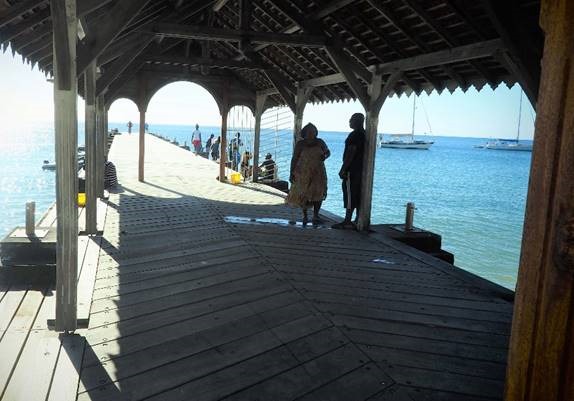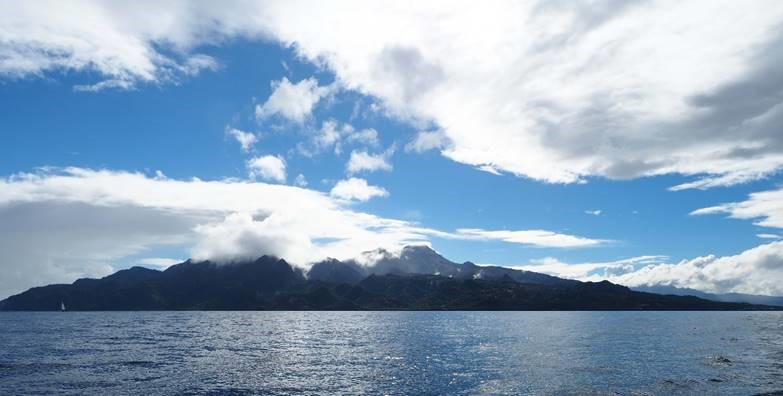27 Feb - Windward to Leeward

|
14:44.1N 061:10.7W The passage up the west coast of Martinique to St Pierre from Anse d’Arlet was splendid: for the first time for several weeks we had no reefs in the sails and indeed, four miles short of St Pierre the wind died and we had to motor the last bit. We even saw dolphins – oddly the first since we arrived on this side of the Atlantic. We see plenty of flying fish, a turtle or two and birds - frigate birds and boobies are never far away, but there are no obvious equivalents to the voracious English seagull here – the nearest thing would be pelicans who tend to prefer the quieter spots and are not interested in foraging for scraps. St Pierre occupies a unique place in Martinique’s history. It used to be the island’s commercial and cultural centre, but in 1902 a series of eruptions from nearby Mt Pelée killed 30,000 inhabitants. The government had ignored the earlier rumblings, no doubt concerned that if they evacuated the place and nothing happened, they would be finished – but it appears nobody quite believed that the Ascension Day eruption would be quite as severe as it was. Apparently, it was on the scale of a large atomic bomb. Almost everyone in the town was immolated and ships in the harbour destroyed: there were two survivors, a cobbler and a chap in prison on death row.
Escapade at anchor off St Pierre, with the volcano generating weather as usual! Today, you can see plenty of evidence of the destruction. Many houses are formed from the remains, other ruins lie derelict with nature gradually reclaiming them. The mountain looks like a normal, dormant volcano to me: plenty of agriculture on the slopes and a calm, Gallic sense of order.
Main street, St Pierre
We anchored close to the beach as the water gets very deep very quickly. The waterfront is much more Caribbean and less touristy than we saw further south. We tied the dinghy up to another of those splendid French town piers and went for a wander. It was Sunday so most things were shut and the place almost deserted. One of the main places to visit is the old theatre. It was destroyed in the eruption but the ruins have been carefully preserved and it looks like a modern version of a Roman amphitheatre. The views to the volcano are glorious. The rest of the town is a tiny bit drab; it’s hard to discern what is a relic of 1902, what might have been ravaged by a hurricane and what has fallen into disuse through the normal cycle of commercial life in the Caribbean. There’s plenty of colour around though and overall it looks a bit like a run down quarter of New Orleans. We had lunch in a good French restaurant, run by ‘yachties’ who did what we are doing and never got any further than this. Fortified by a couple of glasses of wine, we returned onboard and went snorkelling to clear some barnacles off the hull.
The pier at St Pierre – another fine example of French government investment The following morning, we sailed for the hurricane-ravaged island of Dominica. Martinique is the most northerly of the Windward Islands, so whether justifiably or not, we found ourselves ‘not quite close hauled’ on our passage across the 30 mile wide Dominica Channel. Initially the sea was calm and the wind light. As we drew parallel with the north west corner of Martinique, we came across a pod of about 20 pilot whales who swam with us for about half an hour. Their behaviour was almost dolphin-like, making relatively close passes under the boat and in a couple of instances, jumping right out of the water. Their relative bulk (they are about four times the size of a dolphin) and slow speed gave the scene a memorable, slow-motion quality. Nonetheless, it was hard to capture on camera and a reminder that apart from flying fish and turtles, we haven’t seen much marine life whilst on passage on this side of the Atlantic. Soon, rough seas and a brisk easterly wind meant that we had to find the right balance between powering through some big seas and carrying too much sail. The weather promised the usual mix of sunshine and heavy showers, but fortunately we managed to dodge the worst of the downpours. Both islands are distinctively volcanic and the northern tip of Martinique looked particularly ‘other-worldly’ as we left it astern – black clouds, brilliant sunshine, steam rising from rainforest-covered ravines and peaks that you find only in the movies.
Looking back to the north west corner of Martinique We made good progress, and ahead the weather over Dominica looked more settled. There are at least seven potentially active volcanoes here and the skyline is suitably impressive. As we got closer, you could see evidence of the damage caused by Hurricanes Irma and Maria during 2017. The rainforest seemed patchier; it was as if someone had mowed the grass with a blunt lawnmower and pulled out 30% of the grass in the process. There was a colourful village on the very south west tip of the island which from a distance appeared intact, but closer investigation revealed that the brighter roofing materials were blue tarpaulins. About one third had a proper roof; one third tarpaulin, the rest none at all. I regret now that we stayed a couple of miles offshore in order to try to hold onto some reliable wind and avoid the downdrafts mentioned in the Cruising Guide (Chris Doyle’s highly respected publications are NOT Pilot books in the conventional sense). A couple of other boats dropped their sails and motored closer inshore, better to see the impact of the hurricanes. We had fickle winds, ended up motor sailing and were not quite close enough to form an accurate view of the status of Roseau, the capital and a number of coastal settlements up the western side of the island. Dominica is an unusual island politically. It achieved independence from the British and is a Commonwealth member, but the current Labour government has aligned itself with Venezuela, Bolivia, Guatemala, Nicaragua and a couple of other struggling economies. As a result, China has stepped into the vacuum left by the North American and European states who might have provided greater levels of international aid and development money. Dominica relies on bananas, and banana trees do not do well in hurricanes. On the other hand, they regrow quite quickly. The island has very few beaches, so the tourist market is focused on trekking and eco-tourism in the spectacular mountains. China has invested in the infrastructure over the past few years and received political support at the United Nations in return. The population seems split over this: we heard one story that around 500 Chinese residents were evacuated by Beijing immediately after Irma and have yet to return. We also heard that they have done some good work, particularly providing essential roads. But it was not immediately clear whether they have returned since the hurricanes to repair those roads, or simply pledged funds to do so. Our destination was Portsmouth, the main port in the fine natural harbour of Prince Rupert Bay. Rollo Head on the southern corner of the bay has a smart eco-hotel nestling in the rocks and forest and it was clear that a couple of the main buildings were close to collapse. Several wrecks were strewn along the three miles of beach that line the bay, but it was not immediately clear whether all of these were a direct result of the recent hurricanes. The shoreline looked pretty shabby, with damaged sea walls, fallen trees, the same split of repaired, temporary or absent ‘zinc’ roofing that we had seen elsewhere.
A section of the shoreline at Portsmouth, Dominica. Somebody lives in the front, centre shack At the northern end of the bay is Prince Rupert Bluff. Here, Fort Shirley looked in very good condition, but the new cruise terminal buildings below it were clearly abandoned and the pier badly damaged. A half-finished hotel on the seafront had no roof and no windows. There was one of those five-masted Star Clipper cruise ships at anchor in the bay and a couple of dozen yachts anchored or moored in the north east corner. We joined them and picked up a brand new, very smart mooring buoy. We had heard that the Ocean Cruising Club had provided funds and equipment to the Portsmouth Association of Yacht Services (PAYS) to replace their damaged moorings. PAYS is unusual in the Caribbean: the boat boys have formed a ‘collective’ and aim to work together to attract visiting yachtsmen to Dominica. The story is that in the past they would sometimes come to blows arguing with each other over who should ‘service’ a particular visiting yacht and eventually realised that they had given themselves a bad reputation. PAYS was formed to attract visitors and make sure that the locals get a fair share of the income from moorings, tours and other services. We did not have to wait long…
Fort Shirley in good nick. Cruise Ship terminal… mainly trashed.
|





